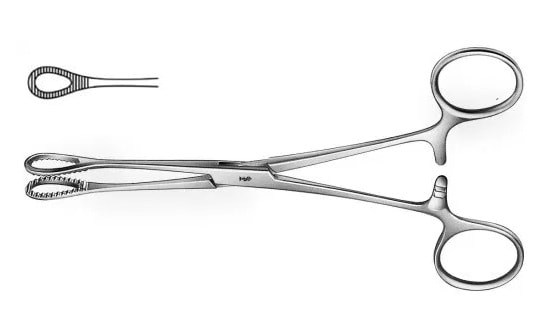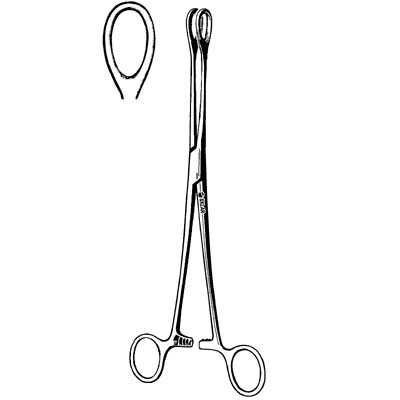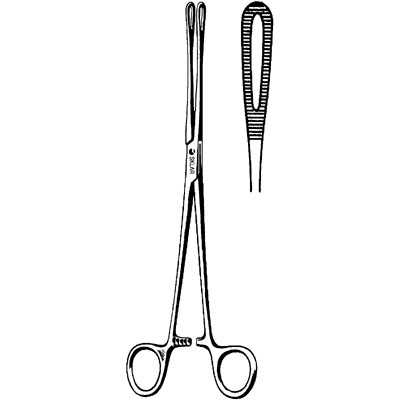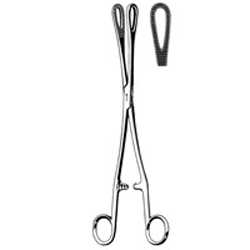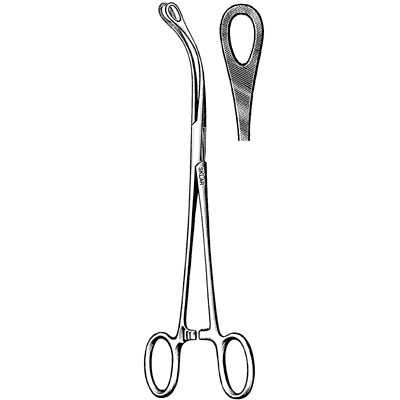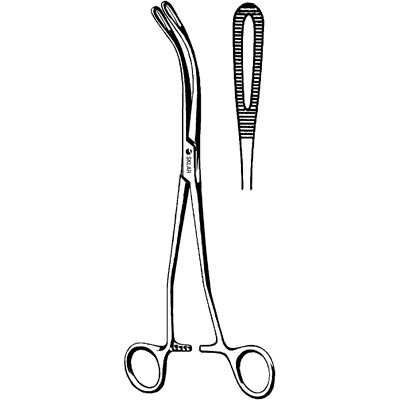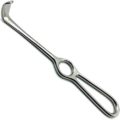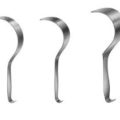Sponge Forceps are also called sponge-holding forceps. Sponge Forceps come in both straight and curved models and feature either smooth or serrated jaws. During most surgical procedures, these forceps have a reserved spot on the instrument mayo stand. While the Sponge Forceps have proven useful in a variety of new surgical techniques, their primary arena has traditionally been gynecological, surgical female sterilization, and abortion procedures. This is because the Sponge Forceps have the ability to grip and manipulate tissue during examinations and minor surgeries with a minimum of damage and trauma.
Sponge Forceps are used both in non-surgical and surgical gynecogical procedures. They are able to atraumatically grasp and hold the bladder or cervix during an examination, and they can be used to manipulate the tissue while the doctor performs the procedure. Doctors also use them to remove stuck membranes they discover while performing cervical examinations and to clamp onto cervical tissue to prevent bleeding.
During post-partum examinations, doctors use the Sponge Forceps to hold and examine the cervix for tearing and to set the cervix while suturing vaginal tears. Doctors have also employed them to clamp the cervix during a procedure known as Vaginal Uterine Artery Ligation. This relatively new procedure helps reduce the loss of blood and to minimize the risk of post-partum hysterectomy. Other gynecological uses for Sponge Forceps include application of an onlay graft during a direct inguinal hernia repair and in gripping and twisting off polyps during polypectomy. Sponge Forceps have proven valuable tools in a variety of surgical birth control strategies.
Straight sponge forceps are used to precisely and atraumatically insert IUD’s. The smaller Ballenger models measure 7″ in length and come with both smooth and serrated jaws. The larger Foersters and Bauer models measure 9-1/2″ and also come with both smooth and serrated jaws. Additionally, the Bauer models feature elongated tips for delicate procedures. In abortion operations, curved forceps steady and hold the uterus and cervix in place during the procedure and can atraumatically draw down the cervix for inspection after the procedure. In some cases, they can also assist in post-abortive tissue evacuation. In female sterilization operations, many doctors especially prefer the curved Foerester model found in our Instruments inventory.
In other surgical arenas, Sponge Forceps assist doctors in a number of operations. Surgeons consider them standard thoracic instruments when performing lung surgeries such as bullectomies. The blunt tips these devices offer prove excellent tools to grasp and collapse the lung and manipulate lung tissue for complete exploration. Surgeons will also use sponge-holding forceps with tonsil wipes to treat pleural abrasions, and they will often use them in colposcopy operations to hold dry or moist cotton balls. The tong-like tips of Sponge Forceps make them excellent tools when handling sponges, gauzes, or sensitive medical supplies. Deaver Retractor
Types of Sponge forceps and their Uses
Foerster sponge forceps are imperative for gynecologic surgery. Sponge forceps look like oval tips and have serrations, the Foerster is utilized to grip sponges throughout the surgical procedure. The term Foerster is a symbolic term in German for commitment to quality and precision. The ratchet handle empowers the surgeon to grip the sponges strongly. Foerster Sponge Forceps are also known as Foerster-Ballenger Sponge Forceps. Sponge forceps are commonly utilized in surgical procedures to firmly clasp gauze squares that will hold abundant fluids and blood from the operatable region or surgical hemostasis. The locking mechanism is built by a ratcheting system. It helps the surgeons to hold the gauze firmly and place it in the right position.
How to Make Surgical Equipment Last Longer
The importance of reliable equipment in the surgical sector can’t be overstated. Between the delicacy required for surgeries and the accuracy a surgeon needs to make these procedures a success, a lot rides on surgical equipment. A surgeon can only be as sharp as their equipment, and proper maintenance is essential to the equation. To keep surgical equipment in its best usable condition, you need to know how to maintain it. Cleaning, sterilization and proper storage are essential to keeping surgical instruments at their best for sustained use. By following this guide, you can increase surgical equipment lifespan and get the best out of your surgical tools for years to come.
The Basics of Surgical Equipment Care
There are multiple options for keeping your instruments in tip-top shape. If you know how to maintain your surgical instruments, you can extend their usable life while ensuring they provide the best service over time. Most surgical instruments can last years if you give them proper care at regular intervals. The care of instruments consists of three distinct steps — cleaning, disinfecting and sterilizing.
Cleaning Surgical Equipment
Cleaning removes dirt and any biological material from your surgical instruments before you move on to sterilization and disinfection. If dirt, bodily fluids or tissue make it onto your surgical instruments, they can damage the surface in addition to making the tool harder to clean. Instruments should be rinsed in cool water rather than hot since the heat can cause substances to coagulate if they contain enough protein. SEE Neurosurgery Instruments and Their Uses

